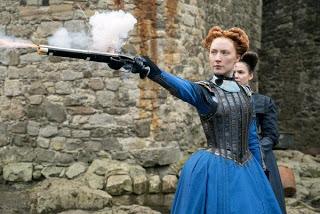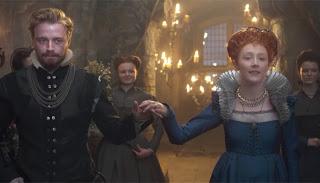 Time again to revisit the rivalry between Elizabeth I and Mary Stuart, already the subject of myriad films, novels, plays and most recently a television series. Freshman director Josie Rourke's Mary Queen of Scots (2018) offers everything you'd expect from a handsomely-mounted period piece: beautiful scenery, elaborate art direction, two game actresses in powerhouse roles. All that's missing is anything to make it stand out from the crowd.
Time again to revisit the rivalry between Elizabeth I and Mary Stuart, already the subject of myriad films, novels, plays and most recently a television series. Freshman director Josie Rourke's Mary Queen of Scots (2018) offers everything you'd expect from a handsomely-mounted period piece: beautiful scenery, elaborate art direction, two game actresses in powerhouse roles. All that's missing is anything to make it stand out from the crowd. Mary Stuart (Saoirse Ronan) returns to Scotland after the death of her husband, the King of France, to assert her claim on the Scottish throne. Facing recalcitrant nobles led by her half-brother James, Earl of Moray (James McArdle) and bitter Protestant resistance fanned by John Knox (David Tennant), Mary nonetheless outmaneuvers her enemies through guile, courage and cunning. But her insistence that she's the rightful heir to England's throne as well irritates Elizabeth (Margot Robbie), who fears a Catholic challenge to her rule and authorizes William Cecil (Guy Pearce) to undermine Mary. A key part of their plan is Lord Darnley (Jack Lowden), a noble wastrel who marries Mary, only to prove himself a dissolute, homosexual lout. Eventually Mary's rule collapses, leaving her at Elizabeth's mercy.
Mary Queen of Scots covers well-trod ground: the clash between Mary and Elizabeth has animated dramatists since Friedrich Schiller. There's something irresistible in the clash of two drastically different women: Mary, usually cast as a hopeless romantic out of her depth, against the loveless, domineering Elizabeth, with political and religious . It's a shame that Rourke and screenwriter Beau Willimon mostly revisit familiar beats: anyone who's seen the 1971 film with Vanessa Redgrave, or TV's Reign, or the million other treatments of this subject, won't find anything new to chew over. That leaves us mostly to evaluate Rourke's artistic choices, which are a decidedly mixed bag.
 Perhaps it's Rourke's theater background that informs her mis-en-scene, as Mary Queen of Scots at least looks different than most epics. Indeed, she and cinematographer John Mathieson blend splendorous Scottish highlands with a relatively small cast: forbidding cliffs and mountains, along with cavernous, tomb-like interiors host council meetings, love scenes and intimate conversations. Even the film's big battle scene seems strangely underpopulated. There's also much interplay between the elaborate settings of Elizabeth's court and the dark, dreary settings of Mary's besieged Scottish world. The movie is quite handsome to look at, yet it's often undercut by questionable dramaturgy.
Perhaps it's Rourke's theater background that informs her mis-en-scene, as Mary Queen of Scots at least looks different than most epics. Indeed, she and cinematographer John Mathieson blend splendorous Scottish highlands with a relatively small cast: forbidding cliffs and mountains, along with cavernous, tomb-like interiors host council meetings, love scenes and intimate conversations. Even the film's big battle scene seems strangely underpopulated. There's also much interplay between the elaborate settings of Elizabeth's court and the dark, dreary settings of Mary's besieged Scottish world. The movie is quite handsome to look at, yet it's often undercut by questionable dramaturgy.Some of Rourke's choices are mildly jarring, like the casting of nonwhite actors in key roles, but this isn't any stranger than color-blind Shakespeare productions. Others are more harmful. The movie intercuts heavily between Elizabeth and Mary, in snippets so quick and insubstantial that's hard to keep grounded in either world early on: fortunately, the film dials back this device in later scenes. Yet the contrasts between Mary and Elizabeth are slammed into the viewer, both through painfully obvious dialogue, repeating images and a strange device of making Mary ageless while Elizabeth grows pock-marked, old and besmeared with fright make-up. It's such an awkward device that it borders on caricature, especially in the inevitable face-to-face confrontation.
While broadly accurate, the script makes alterations to make Mary more sympathetic, making her far more tolerant and pluralistic than the real Mary, a staunch Catholic whose "tolerance" was compelled by the knife of Knox and other Protestants at her throat. Trying to make her a sort of ultra-tolerant, even feminist character undercuts everything we know about the real Mary, a well-meaning woman nonetheless very much a prisoner of her time, place and upbringing as a Catholic consort. Similarly, her indulgence of David Rizzio (Ismael Cruz Cordova), a flaming, effeminate homosexual, seems more compelled to win over contemporary audiences than anything historically viable.
 Which is less objectionable than the treatment of Lord Darnley. The movie revisits the 1971 film's device of making Darnley both a dissolute, power-crazed noble and a scheming, depraved homosexual who openly carries on with Rizzio and sodomizes Mary to assert his dominance. There's little historical basis for this, and it perpetrates a sickly regressive view of homosexuality that's hard to stomach in 2018. Certainly it undercuts a movie that tries to present Mary as the woke monarch of the 16th Century, as much as the hoary old interpretation of Elizabeth as a demi-man who sacrifices femininity to role.
Which is less objectionable than the treatment of Lord Darnley. The movie revisits the 1971 film's device of making Darnley both a dissolute, power-crazed noble and a scheming, depraved homosexual who openly carries on with Rizzio and sodomizes Mary to assert his dominance. There's little historical basis for this, and it perpetrates a sickly regressive view of homosexuality that's hard to stomach in 2018. Certainly it undercuts a movie that tries to present Mary as the woke monarch of the 16th Century, as much as the hoary old interpretation of Elizabeth as a demi-man who sacrifices femininity to role.Saoirse Ronan does beautiful work, even if it's jarring to see the star of Lady Bird back in period costume. She manages the right blend of youthful exuberance, fierce intelligence and haughty desperation to make Mary a compelling protagonist. Margot Robbie delivers a forceful performance that's often undercut by a script unsure how to handle her character. Sometimes she's the fearsome Queen Bess we all know, other times she's mooning over Mary and pouting about her own weakness. The supporting cast features game players like David Tennant (nearly unrecognizable in Rasputin beard), Guy Pearce and James McArdle; Gemma Chan, recently seen in Crazy Rich Asians, appears as one of Elizabeth's courtiers.
Mary Queen of Scots has enough virtues to earn a rental: certainly its audience of Anglophiles and costume enthusiasts should enjoy it. Despite its strengths, it remains a stylish, occasionally stilted rehash of familiar material.

